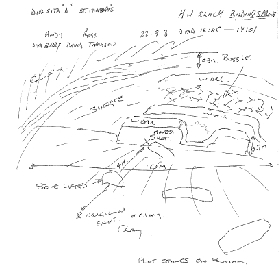Diver Surveys
Diver Surveys were used to ‘ground truth’ the targets seen on the geophysical survey. In total 4 dives were made on St Peter’s and St Nicholas Church ruins. Because of the strength of the tidal currents, dives were made during the two hour slack water between tides. The divers clipped on to a guide rope fixed to a heavy weight that had been dropped onto each target. The divers then descended into the black conditions. Visibility was very poor and photography and filming was not very revealing. The divers mapped structures and materials that they felt on the seafloor, and returned samples of individual stone to the surface. The divers reported feeling stone walls and smooth worked stones at both targets. At the northern target (St Peters Church), one diver reported entering a room like arrangement of flint and mortar walls.
The sea floor is complex at both sites, being covered by stones, clay and compacted rock. On this is lying the broken remnants of medieval flint and mortar walls including worked stones from the churches. Sand sometimes covers and partially buries the ruins, making the job of interpretation and mapping very difficult. Despite this, the divers managed to estimate the dimensions of some of the ruined wall structures, and provided the important evidence that confirmed we had re-discovered the remains of two of the lost Dunwich churches.

Sketch made by Divers from Historic Wreck Recovery, on the 20th and 22nd September 2008 at St Nicholas Church site. Visibility was zero with torches and so the measurements were made by touch. The seabed is complex, with areas of clay, gravel and rubble (large flints). Blocks and wall like structures made of flints were felt by the divers. One block (above) appeared to be smooth.
